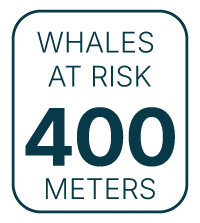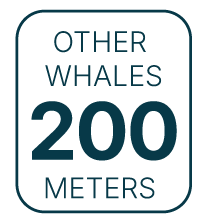Saguenay–St. Lawrence Marine Park Expansion Project
Territory
The expansion project involves 4 administrative regions, 8 RCMs and 27 coastal municipalities. The Wolastoqiyik Wahsipekuk First Nation community will border the expanded Marine Park, in the same way that the Essipit Innu First Nation community does under the park’s current boundaries.

As is the case for the current Marine Park, the planned expansion includes the water column and the seabeds. The area extends to the normal high-water marks, i.e. the maritime boundary delimitation of Quebec public lands.
Elements of Ecological Interest
In the estuary, the salt water of the Atlantic Ocean mixes with the fresh waters of the St. Lawrence River, giving rise to a mosaic of habitats that support a wide array of fauna and flora.
The project will help strengthen protection for:
Beluga
The St. Lawrence is home to the southernmost population of belugas on the planet. The beluga is the also only species of cetacean that inhabits the St. Lawrence year-round. This population is designated “Threatened” by the Government of Quebec and “Endangered” by the Government of Canada.
Currently, 37% of their critical habitat lies within Marine Park boundaries. Critical habitat comprises areas necessary for beluga survival. Including the beluga’s entire critical habitat into the boundaries of the Marine Park will enhance the protection of one of this iconic species.

©GREMM
Rorquals
Every summer, blue whales, fin whales, humpback whales and minke whales travel thousands of kilometres to feed in the estuary’s cold, nutrient-rich waters off the coasts of Quebec’s Côte-Nord region. The area targeted for expansion encompasses many important rorqual habitats.
A significant portion of this area, to the southeast of the existing Marine Park, corresponds to important fin whale habitat. Part of the territory targeted for expansion corresponds to the area most used by blue whales in the St. Lawrence Estuary.

© M. Dupuis
Coastal Herbaceous Areas
Coastal herbaceous areas are well represented in the waters of the targeted expansion. The Kamouraska, L’Isle-Verte, L’Isle-aux-Coudres and Longue-Rive sectors are particularly rich in this type of habitat. Being sensitive to anthropogenic disturbance, coastal herbaceous areas will benefit from being integrated into the Marine Park, which will help ensure their preservation.
Exposed to the rhythm of the tides, coastal herbaceous areas are home to diverse and abundant fauna and flora. These areas represent breeding and feeding grounds for many types of fish, which in turn are consumed by a number of predatory species such as the beluga. For many species of birds, these areas also provide choice habitat for nesting, feeding and resting.

© A. Mainguy
Conservation Tools
An overview of the tools that will be applicable in an expanded Marine Park.

Laws Concerning the Saguenay–St. Lawrence Marine Park
As co-managers, the governments of Canada and Quebec have each adopted their own legislation for the Marine Park.
Under the Quebec’s Act respecting the Saguenay–St. Lawrence Marine Park, the following activities are prohibited under this law:
- Prospecting, utilization, harnessing or harvesting of resources for mining or energy production purposes;
- Laying of oil or gas pipelines or power lines.
The Marine Activities in the Saguenay–St. Lawrence Marine Park Regulations stem from the federal Saguenay–St. Lawrence Marine Park Act. They were developed in collaboration with users and regional stakeholders. Parks Canada is responsible for enforcing these regulations.

Marine Activities in the Saguenay–St. Lawrence Marine Park Regulations

The Marine Activities Regulations aim to reduce the impact of human activities on marine wildlife, and they help maintain a high-quality visitor experience.
They regulate nautical activities by setting speed limits, distances to be respected and behaviour to be adopted in the presence of whales.
Speed

All users, including the shipping industry, must abide by the 25-knot speed limit within the park. Speed limits aim to reduce the risk of collision with whales and limit noise disturbance within their habitat.
Distances


Whether for recreation or for commercial activities, operators of motorboats, sailboats or human-powered watercrafts must maintain their distance in the presence of whales, namely 400 m for species at risk such as the beluga, North Atlantic right whale and blue whale, and 200 m for other species such as the minke whale and humpback whale.
Belugas

Should one or more belugas appear in proximity to a watercraft, the latter’s operator shall move away while maintaining a constant direction and speed until they are at least 400 m away from the animal(s).
Watercraft operators (human-powered watercrafts excluded) that find themselves less than 0.5 nautical miles (926 m) from a beluga shall not remain stationary. Rather, they shall move away at a constant speed of no less than 5 knots and no more than 10 knots.
Prohibited Activities
In order to enhance ecosystem protection or maintain the quality of the experience for visitors and shoreline residents, certain activities are prohibited.
• Personal watercraft
• Hovercraft
• Towed water sports using a motorized engine
• Drone and aircraft flights below 2,000 feet (609.6 m)
• Commercial services related to the hunting of migratory game birds*
*Recreational hunting remains permitted
Activities requiring a permit
Certain activities carried out in the Marine Park require a permit from Parks Canada. The permit ensures that the activity will be conducted in coherence with the park’s mandate.
• Commercial excursion (cruise, guided sea kayaking, sailing school, etc.)
• Scientific research
• Ferry and shuttle service
• International cruise
• Special activity (film shoot, sporting event, aircraft flight, etc.)

Other Laws and Regulations
Other laws and regulations are also applicable in the Marine Park; they are the responsibility of the ministries that draft them. Recreational and commercial fishing, shellfish harvesting, and shipping are examples of activities permitted within the Marine Park and subject to the same regulations as elsewhere in the St. Lawrence.
Achieving the Marine Park’s objectives is contingent on efficient collaboration with those ministries that have a role to play in the management of such activities and in marine conservation.

Commitments
In hindsight, after 25 years of existence, five keys to success have helped forge the Marine Park’s current identity. Park managers will build on this experience to administrate the expansion.
Better Understanding for Better Protection
Park managers will undertake to promote research, notably through partnerships with organizations that are already active in the region. The Marine Park’s ecological sustainability monitoring program will be adjusted to better track the evolution of ecosystems in the expanded Marine Park with the aim of better protecting them.
Acting in Consultation
Marine Park managers will rely on consultation and consensus building to develop and implement new conservation measures as required. The zoning plan, the adoption of new voluntary measures and the protection of sensitive habitats are examples of measures that might be developed with local stakeholders. Collaboration with ministries and organizations having responsibilities in the area will be increased.
Promoting Partnerships
Managers will continue to prioritize the partnership model in the expanded Marine Park. Scientific and educational activities as well as the tourism offering will extend into the expanded park, notably through partnerships with organizations already established in the region. Building on the public’s familiarity with Sépaq and Parks Canada, the expansion of the Marine Park will be an opportunity to promote discovery and educational activities related to the river while supporting the maintenance and development of a sustainable tourism offering that revolves around the St. Lawrence.
Liaising with Local Communities
The presence of a marine protected area adjacent to riverside communities will be an asset for preserving the quality of the marine environment and landscapes. Marine Park teams will be involved with local communities on both shores of the St. Lawrence Estuary. Marine Park activities will be adjusted to the territory and its stakeholders, as well as to any issues and opportunities that might arise.
Involving More Local Representatives in Governance
The makeup of the coordination committee will be adjusted to adequately represent the new reality of the expanded Marine Park. Newly concerned RCMs following the park’s expansion will be entitled to a seat on the committee. Representatives of non-government organizations will also be added to the committee. Further, advisory committees could be created on specific themes such as structuring of the visitor experience or enhancement of the scientific research program.






